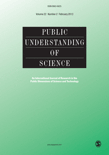
PUBLIC UNDERSTANDING OF SCIENCE
Scope & Guideline
Exploring the Dynamics of Public Perception
Introduction
Aims and Scopes
- Science Communication Strategies:
The journal explores various methods and strategies for effective science communication, emphasizing the importance of tailoring messages to diverse audiences. - Public Perception of Science:
Research on how the public perceives scientific information, including trust in science, understanding of scientific concepts, and attitudes toward scientific innovations. - Role of Media in Science:
Analysis of how different media forms (traditional and digital) influence public understanding and engagement with science, including the impact of misinformation and framing. - Crisis Communication in Science:
Examination of science communication during crises, such as pandemics or climate emergencies, and how these situations affect public trust and understanding. - Engagement and Participation:
Focus on public engagement with science, including citizen science initiatives and the role of various stakeholders in the science communication process. - Cultural and Societal Influences:
Investigating how cultural, ideological, and societal factors shape public understanding and attitudes towards science, including issues related to gender, race, and religion.
Trending and Emerging
- Misinformation and Trust in Science:
A significant increase in research addressing misinformation, especially in the context of the COVID-19 pandemic, and its effects on public trust in science and scientists. - Digital and Social Media Engagement:
The rise of studies focused on science communication through digital platforms and social media, exploring how these channels facilitate or hinder public engagement with science. - Climate Change Communication:
Growing emphasis on how climate change is communicated to the public, including strategies to counteract climate denial and foster public understanding of climate issues. - Public Health and Science Communication:
Emerging research on the communication of health-related science, particularly during health crises, and how public perceptions impact health behaviors and policy. - Diversity and Inclusion in Science Communication:
Increased focus on how diverse voices and perspectives shape science communication and public understanding, emphasizing the importance of inclusivity in science engagement.
Declining or Waning
- Historical Perspectives on Science:
There has been a noticeable decline in papers focusing on historical analyses of science communication, suggesting a shift towards contemporary issues and practices. - Focus on Traditional Media:
Research centered on traditional media outlets is decreasing as the journal increasingly emphasizes digital platforms and social media's role in science communication. - Niche Scientific Discourses:
Themes related to niche scientific topics or specialized discourses seem to be waning, possibly in favor of more broadly relevant and impactful science communication topics.
Similar Journals
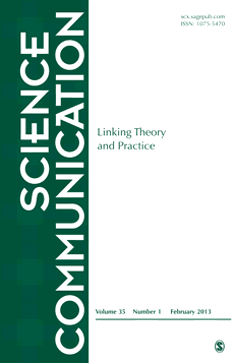
SCIENCE COMMUNICATION
Elevating Science Literacy for a Better TomorrowSCIENCE COMMUNICATION is a premier journal that has established itself as a vital platform for the exploration of the intersection between science, society, and communication practices. Published by SAGE Publications Inc, this journal boasts a commendable impact within the field, evidenced by its 2023 ranking as Q1 in Sociology and Political Science, placing it in the top percentile of its category. With an impressive Scopus rank of 14 out of 1466 in the social sciences domain, it serves as an essential resource for researchers, professionals, and students dedicated to understanding how scientific information is communicated and perceived across various platforms and audiences. Spanning a rich publication history from 1979 to 2024, SCIENCE COMMUNICATION publishes original research, case studies, and reviews that contribute to the development of effective communication strategies in science. Although the journal does not currently offer open access options, its content remains pivotal for fostering informed discourse within academia and beyond. Engaging with this journal is invaluable for anyone interested in enhancing science literacy and engagement in contemporary issues.
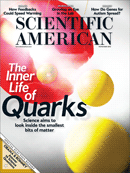
SCIENTIFIC AMERICAN
Illuminating Complex Ideas for a Broader AudienceSCIENTIFIC AMERICAN, published by Springer, stands as a prestigious multidisciplinary journal dedicated to disseminating cutting-edge scientific knowledge across a range of fields. Established in 1947, this journal has been integral in bridging the gap between scientific research and public understanding, making complex ideas accessible to a broader audience. With an ISSN of 0036-8733 and E-ISSN of 1946-7087, it maintains a strong standing within the academic community, currently ranked in the Q3 category for its multidisciplinarity, and is positioned at #93 out of 120 in its Scopus ranking, reflecting its valuable contribution to scientific discourse. While the journal is not open access, its long history and commitment to knowledge sharing ensure it remains a vital resource for researchers, professionals, and students alike, fostering a deeper appreciation of science in society.
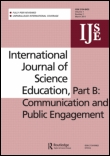
International Journal of Science Education Part B-Communication and Public Engagement
Elevating public engagement through scholarly insights.The International Journal of Science Education Part B: Communication and Public Engagement, published by Routledge Journals, Taylor & Francis Ltd, is a leading peer-reviewed journal dedicated to advancing research in the evolving fields of science communication and public engagement in education. With an ISSN of 2154-8455 and E-ISSN of 2154-8463, the journal has established itself as a key resource for researchers, educators, and practitioners interested in innovative communication strategies and engagement practices that enhance public understanding of science. It holds a commendable Q2 ranking in both the Communication and Education categories for 2023, reflecting its significant impact within academia—ranked 139th in Social Sciences Communication and 515th in Social Sciences Education based on Scopus metrics. Over its publication years from 2011 to 2024, the journal has provided a platform for scholars to share their insights and empirical findings, fostering dialogue and collaboration among professionals. Although it does not offer open access, it remains a vital source of knowledge, keeping stakeholders informed about the latest developments in science education and public outreach.
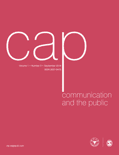
Communication and the Public
Bridging communication theory and public engagement for impactful insights.Communication and the Public is an esteemed journal dedicated to advancing the field of communication studies, published by SAGE Publications Ltd. With its focus on the interplay between communication practices and public engagement, the journal serves as a crucial platform for researchers, professionals, and students alike. Established in 2016 and continuing through to 2024, it holds a prestigious Q1 rank in Communication, underscoring its significant contributions to scholarly discourse—evidenced by its solid placement in the Scopus Ranks at 131 out of 511 in the Social Sciences Communication category, positioning it in the top 74th percentile. While it currently operates under a traditional access model, the journal aims to foster open dialogue and disseminate impactful research that shapes public understanding of communication processes. With an ISSN of 2057-0473 and an E-ISSN of 2057-0481, Communication and the Public continues to be an essential resource for those seeking to explore the nuances of communication in public contexts.
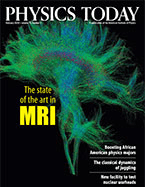
PHYSICS TODAY
Charting the Course of Modern Physics and AstronomyPHYSICS TODAY is a prestigious journal published by the American Institute of Physics, serving as a pivotal platform for the dissemination of innovative research and developments in the field of physics and astronomy. With an ISSN of 0031-9228 and an E-ISSN of 1945-0699, this journal has been in circulation since 1948 and is set to continue until 2024. Recognized for its substantial contributions to the scientific community, PHYSICS TODAY holds a significant position within the Q2 quartile of the Physics and Astronomy category as of 2023. Although it does not offer open access, its articles remain crucial resources for researchers, professionals, and students seeking to stay abreast of the latest advancements across a broad range of topics in general physics and astronomy. With a current Scopus ranking of #150 out of 243 and a percentile standing at 38, the journal bolsters its reputation as a reliable source for high-quality scientific discourse. In an era of rapid scientific advancement, PHYSICS TODAY remains dedicated to fostering a deeper understanding of the physical universe, making it an essential read for those invested in the future of physics.

Spontaneous Generations-Journal for the History and Philosophy of Science
Unraveling the Threads of Scientific Thought Through TimeSpontaneous Generations: Journal for the History and Philosophy of Science is a dedicated publication focusing on the rich fields of history and philosophy within the scientific domain. Published by the Institute for the History and Philosophy of Science and Technology, this journal provides a vital platform for scholars, researchers, and students to explore and disseminate ideas that bridge the historical context and philosophical inquiries of scientific practices. With its commitment to open access, Spontaneous Generations ensures that groundbreaking research is widely available, fostering an environment of collaboration and knowledge sharing. Aiming to engage a diverse audience, this journal is pivotal for those looking to understand the evolution of scientific thought and its implications on contemporary issues, making it an essential resource in the academic community.

Metode Science Studies Journal
Exploring the Intersections of Knowledge and InquiryMetode Science Studies Journal, published by UNIV VALENCIA, BOTANICAL GARDEN UV, is an esteemed open-access journal dedicated to advancing scholarly discourse in the fields of history and philosophy of science and multidisciplinary studies. Since its inception in 2013, the journal has positioned itself as a vital resource for researchers, professionals, and students, fostering an environment for innovative research and cross-disciplinary dialogue. Based in the vibrant city of Valencia, Spain, this journal aims to publish high-quality articles that explore the intricate relationships between scientific practices and philosophical inquiries. With a current impact factor demonstrating its relevance in the academic community, the journal is indexed in Scopus, ranking in the 52nd percentile for history and philosophy of science and the 33rd percentile for multidisciplinary studies. Scholars can access a breadth of research outputs that span from 2015 to 2024, thereby contributing significantly to the intellectual landscape of the respective fields.

SCIENCE AS CULTURE
Advancing Understanding of Science's Role in Cultural ContextsSCIENCE AS CULTURE is a distinguished journal published by Routledge Journals, Taylor & Francis Ltd, focusing on the interdisciplinary intersections of science and culture since its inception in 1987. With an ISSN of 0950-5431 and an E-ISSN of 1470-1189, the journal has established a strong reputation in various academic fields, most notably holding Q1 rankings in Cultural Studies, Health (Social Science), History and Philosophy of Science, and Sociology and Political Science. The journal aims to provide a platform for innovative research that critically examines the social, cultural, and political dimensions of scientific practices and knowledge. Despite not being an Open Access publication, it remains accessible to a wide audience, bolstered by its impressive impact factor and the rigorous peer-review process that ensures the quality of published articles. As a key resource for researchers, professionals, and students alike, SCIENCE AS CULTURE invites contributions that challenge traditional perspectives and stimulate dialogue across the sciences and humanities.

Profesional de la Informacion
Elevating Scholarship in Library and Information SciencesProfesional de la Informacion is a leading academic journal dedicated to advancing research in the fields of Communication, Cultural Studies, Information Systems, and Library and Information Sciences. Published by EDICIONES PROFESIONALES INFORMACION SL-EPI, this journal has established itself as a pivotal resource for scholars and practitioners alike since its inception in 2006, holding an impressive Q1 ranking across its categories in 2023. With an impactful presence reflected in its Scopus Rankings—33rd out of 511 in Communication and 26th out of 280 in Library and Information Sciences—Profesional de la Informacion provides a forum for innovative research and discussion. Although it operates under a subscription model, the journal’s commitment to quality research contributes significantly to the knowledge base within its fields, making it an essential read for those who are passionate about information and communication studies. Positioned in the vibrant academic landscape of Barcelona, Spain, this journal encourages submissions that explore contemporary challenges and advancements in these vital areas of study, solidifying its role as a cornerstone of scholarly discourse.

JCOM-Journal of Science Communication
Elevating Standards: Pioneering Science Communication ResearchJCOM - Journal of Science Communication is a premier, peer-reviewed journal dedicated to enhancing the dialogue between science and society. Established in 2002 by the Scuola Internazionale Superiore di Studi Avanzati in Italy, it has become an essential platform for research in the field of science communication, reflecting the growing importance of effective communication in the advancement of scientific knowledge. The journal boasts an impressive Open Access model, encouraging widespread dissemination of critical research findings. With a notable impact in the Communication category, ranking in the Q2 quartile, and achieving a remarkable 77th percentile in Scopus ranks, JCOM positions itself as a crucial resource for scholars, professionals, and students alike. With a broad scope covering interdisciplinary aspects of science communication, the journal aims to foster innovative research and discussions that bridge the gap between scientific communities and the public. Located in Trieste, Italy, JCOM invites contributions that elevate the standards and practices of communicating science in an increasingly complex world.